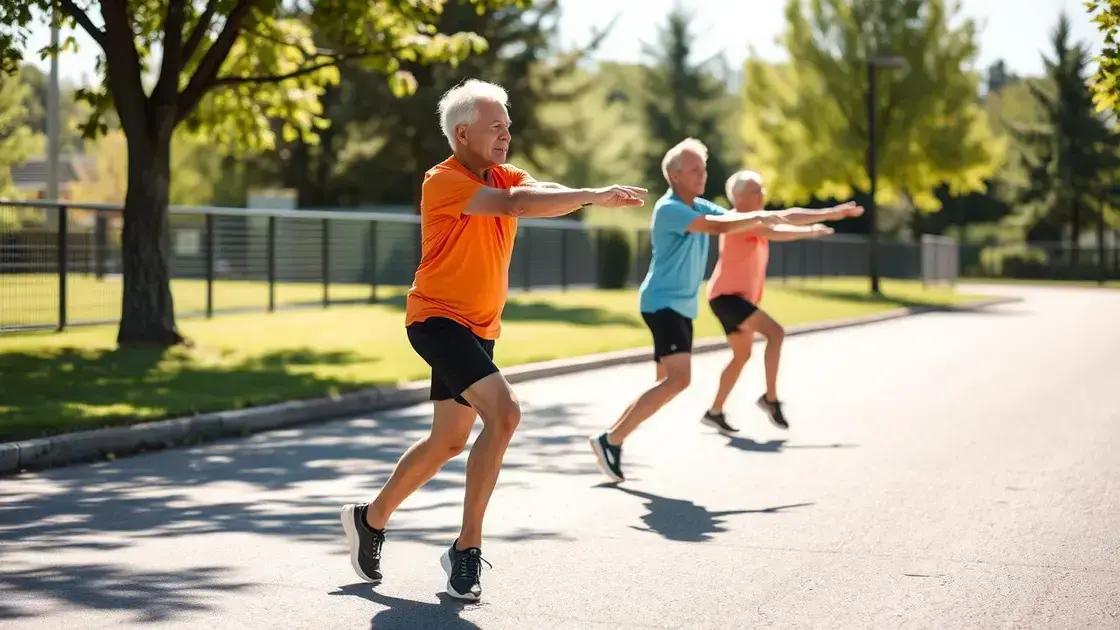Best stretches for runners over 50 include a mix of static and dynamic techniques that enhance flexibility, prevent injuries, and improve overall performance. Key stretches comprise hamstring, quadriceps, and calf stretches, along with dynamic movements like leg swings and walking lunges. Prioritizing safety by warming up, listening to your body, and holding stretches for 20-30 seconds will ensure effective practices for maintaining an active running lifestyle.
Stretching is crucial for runners over 50 looking to maintain mobility and enhance performance. As we age, our muscles and joints require extra attention to stay flexible and injury-free. In this article, we will discuss the importance of stretching, introduce top static and dynamic stretches tailored for older runners, and provide tips for safe stretching practices.
Importance of Stretching for Older Runners

Stretching is vital for older runners as it helps maintain flexibility, prevent injuries, and enhance performance. As we age, our muscles naturally lose elasticity. This can lead to stiffness and a higher risk of injuries if runners do not incorporate stretching into their routine.
Benefits of Stretching
One of the main benefits of stretching is improved mobility. Flexible muscles allow runners to achieve a better range of motion, which is crucial for an effective running stride. Furthermore, stretching can increase blood circulation to the muscles, leading to faster recovery after workouts.
Preventing Injuries
Older runners are more prone to injuries such as strains and sprains. Regular stretching helps to maintain the health of muscles and tendons, reducing the likelihood of these injuries. It also helps with posture, allowing for more efficient running mechanics.
Mind-Body Connection
Engaging in stretching routines can also benefit the mind-body connection. Stretching can serve as a moment of mindfulness, allowing runners to focus on the body. This can lead to enhanced relaxation and mental well-being, making the running experience more enjoyable.
Incorporating stretches before and after runs will help older runners stay active, achieve their fitness goals, and enjoy the many benefits of staying fit.
Top Static Stretches for Runners Over 50

Static stretches are essential for runners over 50 to enhance flexibility and prevent injuries. Below are some of the top static stretches perfect for this age group.
1. Hamstring Stretch
To perform a hamstring stretch, sit on the floor with one leg extended and the other bent. Reach towards your toes of the extended leg. Hold for 20-30 seconds, feeling the stretch along the back of your thigh.
2. Quadriceps Stretch
Stand on one leg and pull your other foot towards your buttocks. Hold your ankle and keep your knees together. This stretch helps with the front of the thigh. Hold for 20-30 seconds and switch legs.
3. Calf Stretch
Find a wall and place your hands on it. Step one foot back, keeping it straight, while bending your front knee. Feel the stretch in your back calf. Hold for 20-30 seconds and switch sides.
4. Piriformis Stretch
Lie on your back with knees bent. Cross one ankle over the opposite knee and gently pull the bottom leg towards you. This stretch helps with the hips and glutes. Hold for 20-30 seconds and switch sides.
5. Shoulder Stretch
Bring one arm across your body and use the opposite arm to push it closer. This will help maintain flexibility in the shoulders. Hold for 20-30 seconds and then change arms.
Incorporating these static stretches into your routine will improve your performance and help you enjoy running for years to come.
Dynamic Stretching Techniques for Flexibility

Dynamic stretching is an effective way for runners over 50 to improve flexibility and prepare their bodies for physical activity. Unlike static stretches, dynamic stretches involve moving parts of your body through a full range of motion. Here are some essential dynamic stretching techniques that can enhance your flexibility.
1. Leg Swings
Stand next to a wall or support for balance. Swing one leg forward and backward in a controlled manner. This motion warms up the hip flexors and hamstrings. Perform 10-15 swings on each leg.
2. Arm Circles
Extend your arms out to the sides and make small circles in the air. Gradually increase the size of the circles. This exercise helps to loosen your shoulders. Do this for about 30 seconds, switching directions halfway through.
3. Walking Lunges
Step forward with one leg into a lunge, keeping your knee above your ankle. Alternate legs as you move forward, engaging your glutes and hip flexors. This dynamic stretch is great for warming up the legs. Aim for 10-12 lunges on each side.
4. High Knees
While jogging in place, lift your knees as high as possible. This elevates your heart rate and warms up your hip joints. Continue for 30 seconds, maintaining a quick pace.
5. Butt Kicks
Jog in place while kicking your heels towards your glutes. This engages the hamstrings and improves flexibility. Keep a moderate pace for about 30 seconds.
Incorporating these dynamic stretching techniques into your warm-up routine can enhance your overall flexibility and prepare your body for a successful run.
Tips for Safe Stretching Practices

Practicing safe stretching is especially important for runners over 50. Here are some vital tips for safe stretching practices to keep in mind:
1. Warm Up First
Always warm up your body before stretching. A short walk or light jog for 5-10 minutes increases blood flow to the muscles, reducing the risk of injury.
2. Don’t Bounce
Avoid bouncing or jerking movements while stretching. Instead, hold your stretches in a smooth and controlled manner to prevent muscle strains and tears.
3. Breathe Normally
Focus on your breathing. Inhale deeply as you stretch and exhale when you hold the position. This helps relax your muscles and allows for better stretches.
4. Stretch Both Sides
Always stretch both sides of your body evenly. This promotes balanced flexibility and strength, which can help improve your running performance.
5. Listen to Your Body
Pay attention to your body’s signals. If you feel pain or discomfort, ease off the stretch. Safe stretching should feel good without causing sharp discomfort.
6. Hold Stretches 20-30 Seconds
Each stretch should be held for at least 20-30 seconds. This allows your muscles to relax and lengthen properly without rushing the process.
By following these tips, runners over 50 can stretch safely and effectively, promoting better performance and reducing the risk of injuries.
In Conclusion: Embrace Stretching for Better Running
Incorporating effective stretching practices into your routine is essential for runners over 50. By focusing on both static and dynamic stretches, you can improve flexibility, enhance performance, and reduce the risk of injuries. Understanding the importance of safe stretching practices, such as warming up properly and listening to your body, will help you enjoy running for years to come.
With the right approach to stretching, older runners can continue to pursue their passion for running, paving the way for a healthier and more active lifestyle.
FAQ – Frequently Asked Questions about Stretching for Runners Over 50
Why is stretching important for runners over 50?
Stretching is crucial for runners over 50 as it helps maintain flexibility, prevent injuries, and enhance overall running performance.
What are the best static stretches for runners over 50?
Some of the best static stretches include hamstring stretches, quadriceps stretches, calf stretches, piriformis stretches, and shoulder stretches.
What dynamic stretching techniques should I use?
Effective dynamic stretching techniques include leg swings, arm circles, walking lunges, high knees, and butt kicks.
How can I ensure that I stretch safely?
To stretch safely, warm up your body first, avoid bouncing, breathe normally, stretch both sides, and listen to your body to prevent injuries.
How long should I hold each stretch?
Each stretch should be held for at least 20-30 seconds to effectively relax and lengthen your muscles.
Can stretching improve my running performance?
Yes, incorporating a proper stretching routine can lead to improved flexibility, better movement efficiency, and reduced risk of injury, ultimately enhancing your running performance.













